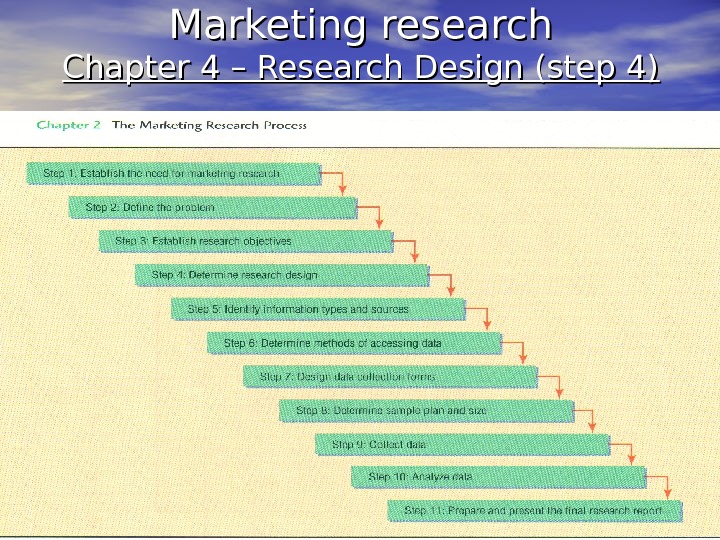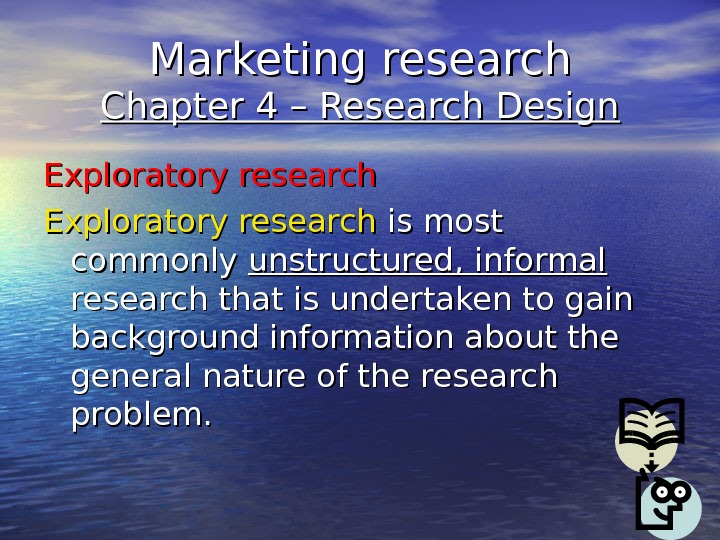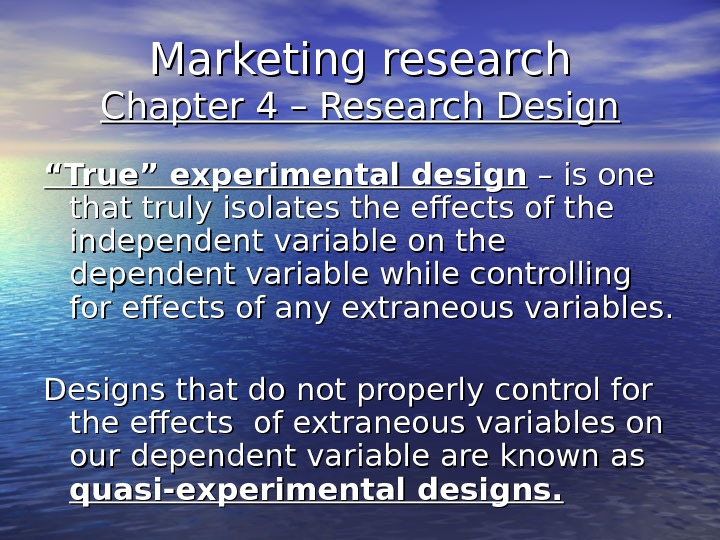Marketing Research Chapter 4 – Research Design



































- Размер: 5.4 Mегабайта
- Количество слайдов: 34
Описание презентации Marketing Research Chapter 4 – Research Design по слайдам
 Marketing Research Chapter 4 – Research Design
Marketing Research Chapter 4 – Research Design
 Marketing research Chapter 4 – Research Design (step 4)
Marketing research Chapter 4 – Research Design (step 4)
 Marketing research Chapter 4 – Research Design A research design – is a set of advanced decisions that makes up the master plan specifying the methods and procedures for collecting and analyzing the needed information
Marketing research Chapter 4 – Research Design A research design – is a set of advanced decisions that makes up the master plan specifying the methods and procedures for collecting and analyzing the needed information
 Marketing research Chapter 4 – Research Design Research designs are classified into 3 traditional categories: exploratory and conclusive (descriptive and causal) The choice of the most appropriate design depends largely — on the objectives of the research; There are 3 objectives: ++ — — and how much we already know about the problem and the research objectives.
Marketing research Chapter 4 – Research Design Research designs are classified into 3 traditional categories: exploratory and conclusive (descriptive and causal) The choice of the most appropriate design depends largely — on the objectives of the research; There are 3 objectives: ++ — — and how much we already know about the problem and the research objectives.
 Marketing research Chapter 4 – Research Design Research Objective Appropriate design To gain background information, to define terms, to clarify problems and hypotheses, to establish research priorities Exploratory To describe and measure marketing phenomena Descriptive To determine causality, to make “if-then” statements Causal. The basic research objectives and research design
Marketing research Chapter 4 – Research Design Research Objective Appropriate design To gain background information, to define terms, to clarify problems and hypotheses, to establish research priorities Exploratory To describe and measure marketing phenomena Descriptive To determine causality, to make “if-then” statements Causal. The basic research objectives and research design
 Marketing research Chapter 4 – Research Design Research design should not be viewed as a step-by-step process. Research may begin with any one of the 3 types of research design. !
Marketing research Chapter 4 – Research Design Research design should not be viewed as a step-by-step process. Research may begin with any one of the 3 types of research design. !
 Marketing research Chapter 4 – Research Design Exploratory research is most commonly unstructured, informal research that is undertaken to gain background information about the general nature of the research problem.
Marketing research Chapter 4 – Research Design Exploratory research is most commonly unstructured, informal research that is undertaken to gain background information about the general nature of the research problem.
 Marketing research Chapter 4 – Research Design Uses of Exploratory Research 1. 1. Gain background information 2. 2. Define Terms “ what is the bank image? ” Location loan availability friendliness of …. employees
Marketing research Chapter 4 – Research Design Uses of Exploratory Research 1. 1. Gain background information 2. 2. Define Terms “ what is the bank image? ” Location loan availability friendliness of …. employees
 Marketing research Chapter 4 – Research Design 3. 3. Clarify Problems and Hypotheses Bank has 3 groups of clients: retail commercial other customers bankscustomers banks
Marketing research Chapter 4 – Research Design 3. 3. Clarify Problems and Hypotheses Bank has 3 groups of clients: retail commercial other customers bankscustomers banks
 Marketing research Chapter 4 – Research Design 4. 4. Establish research priorities Exploratory research can help a firm to prioritize research topics in order of importance.
Marketing research Chapter 4 – Research Design 4. 4. Establish research priorities Exploratory research can help a firm to prioritize research topics in order of importance.
 Marketing research Chapter 4 – Research Design Methods of conducting exploratory research 1. 1. Second data analysis Secondary data are data that have been collected for some other purposes. Secondary data = the “core” of exploratory res. 2. 2. Experience Surveys refer to gathering information from those thought to be knowledgeable on the issues relevant to the research problem.
Marketing research Chapter 4 – Research Design Methods of conducting exploratory research 1. 1. Second data analysis Secondary data are data that have been collected for some other purposes. Secondary data = the “core” of exploratory res. 2. 2. Experience Surveys refer to gathering information from those thought to be knowledgeable on the issues relevant to the research problem.
 Marketing research Chapter 4 – Research Design 3. 3. Case analysis – is a review of available information about a former situation(s) that has some similarities to the present research problem. 4. 4. Focus groups – are small group of people brought together and guided by a moderator through an unstructured, spontaneous discussion for the purpose of gaining information relevant to the research problem.
Marketing research Chapter 4 – Research Design 3. 3. Case analysis – is a review of available information about a former situation(s) that has some similarities to the present research problem. 4. 4. Focus groups – are small group of people brought together and guided by a moderator through an unstructured, spontaneous discussion for the purpose of gaining information relevant to the research problem.
 Marketing research Chapter 4 – Research Design 5. 5. Projective techniques – seek to explore hidden consumer motives for buying goods and services by asking participants to project themselves in to a situation and then to respond to specific questions regarding the situation. ““ Sentence completion test” ““ My neighbor never buys frozen dinners for his family because………”
Marketing research Chapter 4 – Research Design 5. 5. Projective techniques – seek to explore hidden consumer motives for buying goods and services by asking participants to project themselves in to a situation and then to respond to specific questions regarding the situation. ““ Sentence completion test” ““ My neighbor never buys frozen dinners for his family because………”
 Marketing research Chapter 4 – Research Design Descriptive Research Descriptive research is undertaken to describe answers to questions: Who What Where When How
Marketing research Chapter 4 – Research Design Descriptive Research Descriptive research is undertaken to describe answers to questions: Who What Where When How
 Marketing research Chapter 4 – Research Design Who = customer What = product/service/brand Where = places When = time or frequency How = way in which customers are using the product No question Why?
Marketing research Chapter 4 – Research Design Who = customer What = product/service/brand Where = places When = time or frequency How = way in which customers are using the product No question Why?
 Marketing research Chapter 4 – Research Design Classification of description research studies 1. 1. Cross-sectional studies – measure units from a sample of the population at only oneone point in time. == ““ snapshots” of the population
Marketing research Chapter 4 – Research Design Classification of description research studies 1. 1. Cross-sectional studies – measure units from a sample of the population at only oneone point in time. == ““ snapshots” of the population
 Marketing research Chapter 4 – Research Design Sample surveys are cross-sectionals studies whose samples are drawn in such a way as to be representative of a specific problem.
Marketing research Chapter 4 – Research Design Sample surveys are cross-sectionals studies whose samples are drawn in such a way as to be representative of a specific problem.
 Another example of use a cross-sectional study to design a new product.
Another example of use a cross-sectional study to design a new product.
 Marketing research Chapter 4 – Research Design 2. 2. Longitudinal studies repeatedly measure the same sample units of a population over a period of time. == ““ movies” of the population Panels represent sample units who have agreed to answer questions at periodic intervals.
Marketing research Chapter 4 – Research Design 2. 2. Longitudinal studies repeatedly measure the same sample units of a population over a period of time. == ““ movies” of the population Panels represent sample units who have agreed to answer questions at periodic intervals.
 Marketing research Chapter 4 – Research Design There are 2 types of panel: — Continuous panel – ask panel members the same questions on each panel measurement. It can gain insights into changes in in consumers’ purchases, attitudes and so on. — Discontinuous panel – vary questions from one panel measurement to the next.
Marketing research Chapter 4 – Research Design There are 2 types of panel: — Continuous panel – ask panel members the same questions on each panel measurement. It can gain insights into changes in in consumers’ purchases, attitudes and so on. — Discontinuous panel – vary questions from one panel measurement to the next.
 The advantage of Longitudinal studies versus Cross-sectional studies We compare longitudinal data taken form a continuous panel with data collected from 2 separate cross-sectional sample surveys
The advantage of Longitudinal studies versus Cross-sectional studies We compare longitudinal data taken form a continuous panel with data collected from 2 separate cross-sectional sample surveys
 Marketing research Chapter 4 – Research Design Discussion question: What are the differences between longitudinal studies and cross-sectional studies?
Marketing research Chapter 4 – Research Design Discussion question: What are the differences between longitudinal studies and cross-sectional studies?
 Marketing research Chapter 4 – Research Design Discussion question: In what situations would a continuous panel be more suitable than a discontinuous panel? In what situations would a discontinuous panel be more suitable than a continuous panel? Give an examples.
Marketing research Chapter 4 – Research Design Discussion question: In what situations would a continuous panel be more suitable than a discontinuous panel? In what situations would a discontinuous panel be more suitable than a continuous panel? Give an examples.
 Marketing research Chapter 4 – Research Design Causal Research If If xx , then yy. . Yellow Pages ex. Causal relationships are determined by use of experiments.
Marketing research Chapter 4 – Research Design Causal Research If If xx , then yy. . Yellow Pages ex. Causal relationships are determined by use of experiments.
 Marketing research Chapter 4 – Research Design Experiments An Experiment — Independent variables — Dependent variables – Extraneous variables — Sales Market share Level of consumer satisfaction Level of adv. expenditure Location of the display of a product in a supermarket
Marketing research Chapter 4 – Research Design Experiments An Experiment — Independent variables — Dependent variables – Extraneous variables — Sales Market share Level of consumer satisfaction Level of adv. expenditure Location of the display of a product in a supermarket
 Marketing research Chapter 4 – Research Design Sales of apples (dependent variable)The effect of type of display (independent variable) Could there be other extraneous variables that could have affected the sales of the apples? — What would happen with apple sales if the weather changed from rainy to fair? — If the apple industry began running ads on TV? — If the season changed from summer vocation to fall?
Marketing research Chapter 4 – Research Design Sales of apples (dependent variable)The effect of type of display (independent variable) Could there be other extraneous variables that could have affected the sales of the apples? — What would happen with apple sales if the weather changed from rainy to fair? — If the apple industry began running ads on TV? — If the season changed from summer vocation to fall?
 Marketing research Chapter 4 – Research Design Experimental design O -O — X -X — R -R — E — OO 1 1 OO 22 Pretest and posttest —
Marketing research Chapter 4 – Research Design Experimental design O -O — X -X — R -R — E — OO 1 1 OO 22 Pretest and posttest —
 Marketing research Chapter 4 – Research Design ““ True” experimental design – – is one that truly isolates the effects of the independent variable on the dependent variable while controlling for effects of any extraneous variables. Designs that do not properly control for the effects of extraneous variables on our dependent variable are known as quasi-experimental designs.
Marketing research Chapter 4 – Research Design ““ True” experimental design – – is one that truly isolates the effects of the independent variable on the dependent variable while controlling for effects of any extraneous variables. Designs that do not properly control for the effects of extraneous variables on our dependent variable are known as quasi-experimental designs.
 Marketing research Chapter 4 – Research Design 1. 1. After-only design X OX O 11 2. One-group, before-after design OO 1 1 X O 22 3. Before-after with control group Experimental group (R) O 1 1 X O 22 Control group (R) O 3 OO 44 Where E = (O 22 — O 11 ) – (O 44 — O 33 ). ). — 2 2 groups are equivalent in all aspects — R R – we randomly divided our supermarkets — We may measure
Marketing research Chapter 4 – Research Design 1. 1. After-only design X OX O 11 2. One-group, before-after design OO 1 1 X O 22 3. Before-after with control group Experimental group (R) O 1 1 X O 22 Control group (R) O 3 OO 44 Where E = (O 22 — O 11 ) – (O 44 — O 33 ). ). — 2 2 groups are equivalent in all aspects — R R – we randomly divided our supermarkets — We may measure
 Marketing research Chapter 4 – Research Design How valid are experiments? 2 forms of validity are used to assess the validity of an experiment: — Internal Factors: extraneous f. , changes in Subjects, Measure error — External Factors: 1. 1. How representative is the sample 2. 2. Was the sample units correctly selected (sample plan) 3. 3. The correctness of experiment setting itself
Marketing research Chapter 4 – Research Design How valid are experiments? 2 forms of validity are used to assess the validity of an experiment: — Internal Factors: extraneous f. , changes in Subjects, Measure error — External Factors: 1. 1. How representative is the sample 2. 2. Was the sample units correctly selected (sample plan) 3. 3. The correctness of experiment setting itself
 Marketing research Chapter 4 – Research Design Types of Experiments — Laboratory experiments – – is one in which an investigator creates a situation with the desired conditions and then manipulates some variables while controlling others. “ “ + “ and “ – “ Blind taste test
Marketing research Chapter 4 – Research Design Types of Experiments — Laboratory experiments – – is one in which an investigator creates a situation with the desired conditions and then manipulates some variables while controlling others. “ “ + “ and “ – “ Blind taste test
 Marketing research Chapter 4 – Research Design — Field experiments – is a research study in a realistic or natural situation, involves the manipulation of one or more independent variables under as carefully controlled conditions as the situation will permit. “ “ + “ and “ – “ ““ Test marketing” – is the phrase commonly used to indicate an experiment, study or test that is conducted in a field setting.
Marketing research Chapter 4 – Research Design — Field experiments – is a research study in a realistic or natural situation, involves the manipulation of one or more independent variables under as carefully controlled conditions as the situation will permit. “ “ + “ and “ – “ ““ Test marketing” – is the phrase commonly used to indicate an experiment, study or test that is conducted in a field setting.
 Marketing research Chapter 4 – Research Design Types of test markets — Standard test market — Controlled test markets — Electronic test markets Pros and Cons of test marketing
Marketing research Chapter 4 – Research Design Types of test markets — Standard test market — Controlled test markets — Electronic test markets Pros and Cons of test marketing
 Marketing research Chapter 4 – Research Design Discussion question: Design an experiment. Select an independent variable and a dependent variable. What are some possible extraneous variables that may cause problems? Explain how you would control for the effects these variables may have on your dependent variable. Is your experiment a valid experiment?
Marketing research Chapter 4 – Research Design Discussion question: Design an experiment. Select an independent variable and a dependent variable. What are some possible extraneous variables that may cause problems? Explain how you would control for the effects these variables may have on your dependent variable. Is your experiment a valid experiment?

